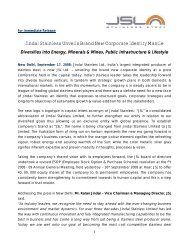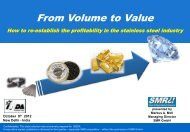September 2011 (PDF format 670 KB) - Indian Stainless Steel ...
September 2011 (PDF format 670 KB) - Indian Stainless Steel ...
September 2011 (PDF format 670 KB) - Indian Stainless Steel ...
Create successful ePaper yourself
Turn your PDF publications into a flip-book with our unique Google optimized e-Paper software.
SIGNIFICANT POTENTIAL FOR STAINLESS STEEL IN BIO ENERGYBiogas typically refers to a gas producedby the biological breakdown of organicmatter in the absence of oxygen. Organicwaste such as dead plant (straws ofcrops like wheat, rice, jowar, bajra, huskof rice etc.), animal material, animaldung, kitchen and human waste etc., canbe converted into a gaseous fuel calledbiogas.The gases-methane, hydrogen andcarbon monoxide (CO) can becombusted or oxidized with oxygen. Thisenergy release allows biogas to be usedas a fuel. Raw biomass can be used asa fuel in any country for any heatingpurpose, such as cooking.Nearly 700 million <strong>Indian</strong>s still burnbiomass as the primary source of energyfor cooking in inefficient cookstoves whichburn wood and other agricultural matterand add to air pollution. In addition, it isa source of health problem in kitchenswith insufficient ventilation.India is the world’s fifth-largest andsecond-fastest-growing producer ofgreenhouse gas emissions. Generatingelectrical power by burning biogas (amixture of methane and carbon dioxideproduced by the bacterial degradation oforganic matter) harnesses thesegreenhouse gases and reduces demandfor fossil fuel-fired generating plants.The Government is exploring thedevelopment of community-drivenbiomass based resources programs tomeet the basic energy needs of thepopulation in areas where electrificationis not possible, such as remote villages.As a climate change co-benefit, a largescale conversion to biomass-energy candecrease India’s greenhouse gasemissions.BIOGAS ENERGY POTENTIALThe Government of India’s Ministry ofNew and Renewable Energy Sources ispreparing a national bio-energy missionto boost power generation from biomass,a renewable energy source abundantlyavailable in India. Surplus biomass inIndia is estimated to be 150 milliontonnes. This could potentially be usedto generate 16 giga watts(16000 MW) ofpower.During the 12th Five-Year Plan (2012-2017), the <strong>Indian</strong> Government isenvisaging to facilitate large-scale capitalinvestments in biomass-fired powerstations. It will provide power for day-todayrequirements of the population,encourage development of ruralenterprises and provide employment toa large number of people in thecountryside. This could also help in thestabilization of electricity grid.Nearly 70% of the country’s populationlives in villages with marginal access toelectricity. Currently, India has a totalinstalled capacity of 3,000 MW ofbiomass-based power generation. Theministry of new and renewable energy istargeting to double this capacity duringthe 12th Plan (2012-17).According to some estimates, biomassfrom agro and agro-industrial residuecould potentially generate 25,000 MW ofpower in India. This can be further raisedwith wasteland-based integrated energyplantation and power generationsystems.Each MW generated from biomassplants would be able to cover about 6,000rural households. The ministry hasearmarked 3,400 crore for the variousincentive schemes under the biomassmission.POWER GENERATION EQUIPMENTWe present a case study (from ‘NickelMagazine’, volume 23, number 3, June2008) where M/s Capstone TurbineCorporation of Chatsworth, California,U.S.A. installed their first micro turbineto produce biogas energy in Purulia,West Bengal in 2006. Based on thisexperience, they installed few moremicro-turbines at different locations inIndia for generating more biogas energy.The Purulia installation is at a dairy farmand consists of two 30-kilowatt microturbinesystems, one of which is forbackup. These can run either linked orindependently of the power grid. “Whenthe grid is down, it is connected to thedairy to keep it running”.The micro-turbines use nickel alloys andstainless steel in components such asthe combustion chamber, spinningturbine, main rotor shaft, recuperatorhousing etc., all of which runcontinuously with minimal maintenance.Austenitic stainless steels are the mostcost-effective material for the systemsthat clean and compress the corrosivebiogas prior to combustion in microturbines.Biogas is mostly methane with hydrogensulphide present as a contaminant. Whenhydrogen sulphide is mixed with water(with which biogas is always 100%saturated), it becomes a weak acid(hydrosulphuric acid). Carbon dioxideforms a mild carbonic acid in thepresence of water. “Biogas is verycorrosive, which is why we use a lot ofstainless steel”.“<strong>Stainless</strong> steel has good corrosionresistance to those acids. Predominantlywe use S30400 and S30403, thoughsometimes customers request S31600and S31603, as these are more resistantto corrosion. The S30403 might last 40-50 years whereas the S31603 can last100 years.”A typical compression and cleaningsystem takes the gas drawn off the topof the sludge in a digester, where manurehas decayed for 20-30 days, andcompresses and cleans it before it isburned. In a simplified description of thisprocess, the gas first passes throughfilters that remove the hydrogen sulphide.These tanks will typically be constructedof stainless steel plate 4.8 or 6.4mmthick and are made to withstand negativepressure. The gas then passes througha compression system, where it is raisedto pressures as high as 8.4 kilogramsper square cm (kg/cm2). The piping usedin this process is typically stainlesssteel. Next it passes through heatexchangers to reduce the temperatureto about 4 °C, forcing more water out ofthe gas. The gas is then re-heated to27 °C, reducing the relative humidity to25%. Subsequently, the gas passes intostainless steel vessels where siloxane,a chemical used in lubricants andpersonal care products, is filtered out.Since siloxane turns into a glass-likesubstance at high temperatures it mustbe removed before the gas is burned.After this step, the biogas is delivered toan end-use device, such as a turbine,internal cubustion engine, or fuel cell.CONCLUSION:Given the big plans the Government hasfor use of bio-gas for energy productionin India, austenitic stainless steels havea significant market potential in thissector because they have proved to bethe most cost-effective material for thesystems that clean and compress thecorrosive biogas prior to combustion.STAINLESS INDIA / VOL. 16, NO.3 PAGE 6
















